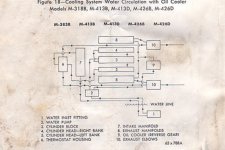Hello,
I have a Chrysler 426 Wedge, which was Model M-426B in a 1967 Century Coronado. The engine has been running great, but I have started having a problem where the starboard exhaust manifold, exhaust elbow and exhaust pipe run way too hot at idle. However, at speed the manifold, elbow and exhaust all cool down to appropriate temp. The port side is fine. Stays at appropriate temp no matter the load or speed.
I was looking at the cooling diagram for this engine which I have attached. It is quite complex. Has 2 impellers in one pump. I don't suspect this is a pump issue as the engine itself runs at the correct temp and the port side is fine as well. All impellers and gaskets were replaced last season and have maybe 20 hrs use.
My suspicion is there may be some obstruction between 9 and 8 on the starboard side? I'm just puzzled because the problem resolves at higher RPMs and is worse at idle.
Does this make sense to anyone?
I have a Chrysler 426 Wedge, which was Model M-426B in a 1967 Century Coronado. The engine has been running great, but I have started having a problem where the starboard exhaust manifold, exhaust elbow and exhaust pipe run way too hot at idle. However, at speed the manifold, elbow and exhaust all cool down to appropriate temp. The port side is fine. Stays at appropriate temp no matter the load or speed.
I was looking at the cooling diagram for this engine which I have attached. It is quite complex. Has 2 impellers in one pump. I don't suspect this is a pump issue as the engine itself runs at the correct temp and the port side is fine as well. All impellers and gaskets were replaced last season and have maybe 20 hrs use.
My suspicion is there may be some obstruction between 9 and 8 on the starboard side? I'm just puzzled because the problem resolves at higher RPMs and is worse at idle.
Does this make sense to anyone?


